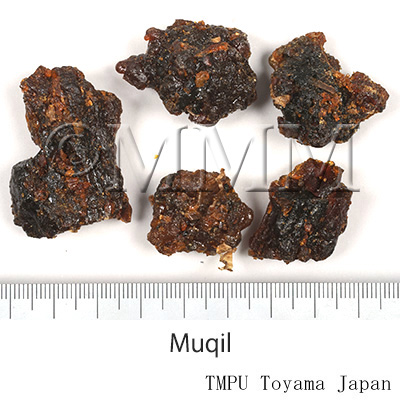Crude drug sample data base
※Click on the image to enlarge it.
The capital city, provincial capital city or the representative
location of its administrative area is indicated.
location of its administrative area is indicated.
Production area information
Islamic Republic of Pakistan
https://ethmed.toyama-wakan.net/img/pin_san.png
25.0700428
67.2847875
Collection information
Islamic Republic of Pakistan,Karachi [Karachi], Sind
https://ethmed.toyama-wakan.net/img/pin_nyu.png
Scientific information data base
| Crude drug name | Urudu name, English name | Muqul, Indian Bedellium | ||||
|---|---|---|---|---|---|---|
| Arabic name / Persian name | Muql, Moql, Muqul Azraq / Bue-jahudan | |||||
| crude drug image |
| |||||
| Original plant name | Commiphora wightii (Arnott.) Bhand. syn. Commiphora mukul (Hook. ex. Stocks) Engl. | |||||
| Family name | Burseraceae | |||||
| Used part | Oleo-gum resin | |||||
| Distribution area | It is found in Eastern Bengal, Assam, Rajputana and Mysore; Sind and Baluchistan. A thorny shrub or tree with Margosa tree like leaves. When injured, it yields an aromatic gum resin. | |||||
| Description | It is reddish-yellow in colour, fragrant and bitter in taste. Its birthplaces are Yemen, Italy and coastal areas of Bay of Oman. Its smoke gives out a smell similar to that of bay tree. | |||||
| Function and properties | Swellings, Ulcers, Joints, Chest, Stomach, Excretion. Resolvent of inflammations, aperient, coctive and purgative of phlegm, expectorant (of phlegm), detersive, carminative, good for piles, antihaemorrhagic/antihemorrhagic, diuretic and emmenagogue, calorific; useful in cases of renal stones and aphrodisiac. | |||||
| Specific actions | Anti-inflammatory and good for piles. | |||||
| Frequency in use | Common. | |||||
| Common uses | Swellings: It dissolves the hard swellings, particularly when used after kneading it with the saliva of a fasting man. Similarly it dissolves all types of cold swellings. It removes scrofula. Its decoction is taken orally in cases of hard internal swellings. Ulcers: It is painted with vinegar on favus. Joints: It is useful in dislocation of muscles, convulsions, stiffness and twisting of the nerves. Being suppurative and laxative it is active against cold phlegmatic disorders e.g. paralysis, rheumatism, gout and sciatica. Chest: Being expectorant useful against phlegmatic asthma, chronic cough and pleuradynia. It is useful in painful swellings of the trachea. Arabian variety also gives relief in inflammatory conditions of larynx and throat. It acts as styptic in haemoptysis//hemoptysis. Stomach: It resolves flatulence and imparts strength to the stomach and sex organ. Excretion: Its oral intake, pessary or fumigation is useful for treating piles. It stops bleeding and proves to be useful in cases of renal stones. When incorporated in purgatives, it stops (gastric) abrasions. It promotes the discharge of urine and menses. It definitely causes constipation and dissolves the stones. Both the varieties of bedellium (Slavonian and Arabian) facilitate downward passage of the foetus, cleanse the uterus and dissolve anal and testicular swellings. | |||||
| Side effect | It is harmful (in higher doses) to lungs and liver. It exhibits adverse affect on placenta. It is useful in cases of insect bite. | |||||
| Medical system | Unani | |||||
| Traditional concept | Temperament | It is hot in the third degree and dry in the second degree. | ||||
| Drug effect | It is resolvent of inflammations and good for piles. But it is considered harmful for lungs and liver (on its prolong use). | |||||
| Dosage | 1 to 1.5gm. | |||||
| Substitute | Mur-Makki (Balsamodendron myrrha T. Nees) and Sibr (Aloes). | |||||
| Related drugs | Commiphora roxburghii (Arn.) Engl. occurring in Central and Eastern India is sold by the name of guggul. It has a bluish tinge and a feeble balsamic odour. It is used as a substitute. | |||||
| Corrigent (corrective) | Katira (Cochlospermum religiosum (L.) Alston) and Za`faran (Crocus sativus Linn.). | |||||
| Important compound preparations | Habb Muqil, Zimad Bawasir and Ma`jun Jograj Guggal. | |||||
| References | Reference book Tips! | Illustrated Manual of Herbal Drugs Used in Ayurveda, 1996. Sarin, Y.K., Council of Scientific & Industrial Research and Indian Council of Medical Research, New Delhi p 330. Indian Materia Medica, Vols. 1-2, 1976 (Repr. 1989). Nadkarni, A.K., Popular Prakashan Pvt. Ltd., Bombay Vol. 1, pp 167-170. Makhzanul-Mufradat (Khawasul Adviyah), Hakeem Kabiruddin, Daftar Al-Masih, Qarol Bagh, Delhi. pp 547-548. Dictionary of Economic Plants in India, 1996 (2nd Rep.). Singh, U; Wadhwani, A. M. and Johri B.M. Indian council of Agricultural Research, New Delhi. p 57. Al-Qanun Fil-Tibb. Avicenna. (English translation of the critical Arabic text), Book 2, 1998. Hameed, H. A. (editor), Dept. of Islamic Studies, Jamia Hamdard (Hamdard University), New Delhi. pp 441-442. Hamdard Pharmcopoeia of Eastern medicine, 1969. Said, H. M. (editor), The Times Press, Sadar Karachi. pp 111, 191, 266. Indusyunic Medicine, 1997. Usmanghani, K., Saeed, A. and Alam, M. T. Department of Pharmacognosy, Faculty of Pharmacy, University of Karachi, Karachi. pp 175-176. Unani Adwiyah Mufradah, 1984. Ali, Saifuddin, A. (3rd edi.). Taraqi-e-Urdu Bureau, R. K. Puram, New Delhi. pp 261-262. | ||||
| Remarks | Avicenna (Ibn Sina) has described this drug under Muqul al Yahud wa al-muqul al makki. As it is an important drug therefore, it is used in various compound preparations. The gum is collected during the winter after incising the stem. After oozing it is congealed. Then it is collected and sold in Indian Bazaars. The drug finds a mention in ancient Arabic books of Unani. Therefore, it is certain that Arab physicians were having the knowledge of this wonderful drug. Indian bedellium burns in fire, melts in the sun and forms a milky emulsion with hot water. The fresh one is moist, viscid fragrant and of golden colour. Oleo-resin is reported to lower cholesterol level of blood. | |||||
| Last renewal date | 2024/03/08 | |||||





